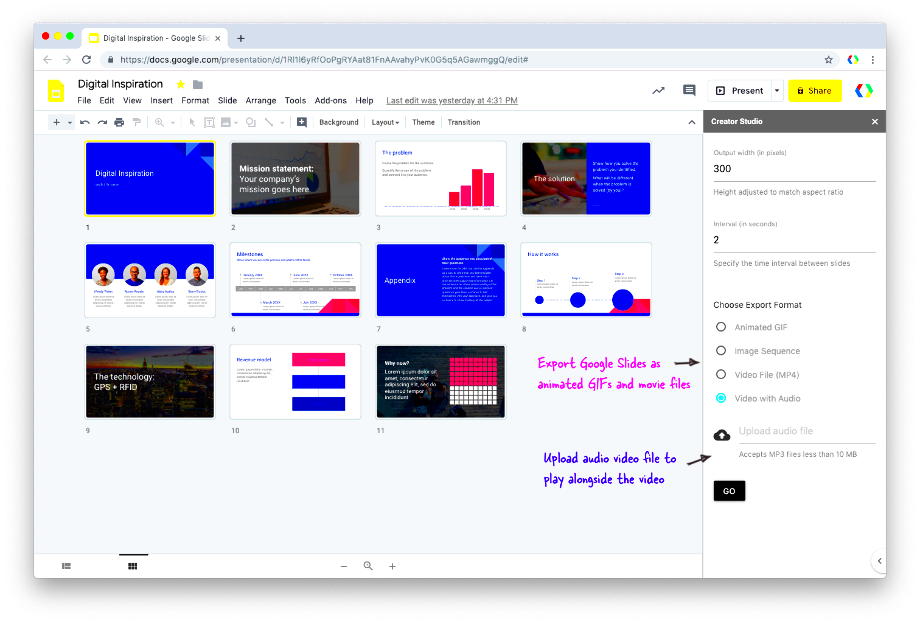Transparent backgrounds can be a game changer when creating presentations in Google Slides. They allow images to blend seamlessly into the slide design, making your content look polished and professional. Imagine wanting to highlight a specific product or idea without any distracting background elements. By removing the background, you focus your audience’s attention right where it belongs.
Transparent backgrounds are particularly useful in the following scenarios:
- Branding: Consistent visuals enhance your brand identity.
- Visual Appeal: Clean slides attract and retain audience attention.
- Versatility: You can place images on any colored background without clashing.
Steps to Make Image Backgrounds Transparent in Google Slides

Making image backgrounds transparent in Google Slides is a straightforward process. Follow these simple steps to enhance your presentations:
- Open Google Slides and select the slide where you want to add your image.
- Click on “Insert” in the menu, then select “Image” to upload your desired picture.
- Once your image appears on the slide, click on it to select it.
- Now, navigate to the “Format options” panel on the right side of the screen.
- Look for the “Adjustments” section and locate the “Transparency” slider.
- Adjust the slider to make the background transparent as needed.
That's it! With these steps, your image will be ready to blend into your slide seamlessly.
Using the Format Options for Transparency
The Format Options in Google Slides are powerful tools for customizing your images. Here’s how you can use them to adjust transparency:
- Adjust Transparency: As mentioned earlier, the transparency slider allows you to control how see-through your image is. Move the slider to see real-time changes.
- Crop Image: If parts of your image still don’t fit your design, you can crop it. Click on “Crop image” in the Format options to adjust the visible area.
- Recolor Images: You can change the color tones of your image, which helps maintain consistency across your presentation.
- Drop Shadow: Adding a subtle shadow can create depth and make your images pop against the background.
These options help you create a visually appealing slide that effectively communicates your message without distractions.
Applying the Magic Eraser Tool
The Magic Eraser Tool is a fantastic feature in Google Slides that can help you remove unwanted backgrounds from images with ease. Instead of manually cropping or adjusting the image, this tool automatically detects and removes the background color, allowing you to focus on what really matters in your presentation. It’s perfect for those who want to streamline their workflow while ensuring high-quality visuals.
Here’s how to use the Magic Eraser Tool:
- First, insert your image into the slide.
- Select the image by clicking on it.
- Go to “Format options” and look for “Adjustments.”
- Find the “Remove background” option, and click on it.
- Once the tool activates, it will highlight the area it considers the background in pink.
- Use the “Mark areas to keep” and “Mark areas to remove” options to refine your selection.
- After you’re satisfied, click on “Done” to apply your changes.
Using the Magic Eraser Tool not only saves time but also enhances your images, making them stand out. It’s a must-try for anyone looking to elevate their presentation style.
Working with Different Image Formats
Understanding image formats is essential when working in Google Slides, as the format you choose can significantly affect the quality and transparency of your images. Some formats support transparency, while others do not. Here are the common formats you might encounter:
| Image Format | Supports Transparency | Best Use Cases |
|---|---|---|
| PNG | Yes | Logos, graphics with clear backgrounds |
| JPG/JPEG | No | Photographs, images without transparency |
| GIF | Yes (limited) | Simple animations, small graphics |
| BMP | No | High-quality images, less common in presentations |
When selecting images for your presentations, consider using PNG files when transparency is necessary. This can help create a cleaner, more professional look.
Tips for Creating Professional-Looking Presentations
Creating a polished and professional presentation goes beyond just making your backgrounds transparent. Here are some tips to help you achieve a stunning final product:
- Choose a Consistent Color Scheme: Stick to a limited color palette to create a cohesive look.
- Use High-Quality Images: Ensure your images are high resolution. Blurry images can detract from your message.
- Limit Text on Slides: Aim for bullet points and short phrases. Your audience should focus on your words, not read everything on the slide.
- Utilize White Space: Don’t overcrowd your slides. White space can enhance readability and focus.
- Incorporate Visuals: Use graphs, charts, and images to support your points. Visual aids can help your audience understand complex information.
- Practice Consistent Fonts: Use no more than two or three fonts throughout your presentation to maintain consistency.
By following these tips, you’ll create presentations that are not only visually appealing but also effectively communicate your message. Happy presenting!
Common Issues and Troubleshooting
Even with the powerful tools available in Google Slides, you might run into some common issues when trying to make image backgrounds transparent. Don't worry; many of these problems are easy to fix! Here are some of the most frequent issues users encounter and their solutions.
- Image Doesn’t Become Transparent: Sometimes, the transparency option may not apply as expected. Make sure you are using a compatible image format like PNG that supports transparency. If you're working with a JPG image, consider converting it to PNG.
- Background Color Still Visible: If parts of the background remain after using the Magic Eraser Tool, try adjusting the “Mark areas to keep” and “Mark areas to remove” options again. Zoom in for more precise selections.
- Quality Loss After Transparency: If you notice a drop in image quality, check if the image was initially high resolution. Using lower-quality images will lead to pixelation once you adjust the transparency.
- Format Options Missing: If you can’t find the Format Options panel, ensure you have clicked on the image you want to edit. Sometimes, it helps to refresh the page if the panel doesn’t appear.
By keeping these troubleshooting tips in mind, you’ll be better equipped to handle common issues and ensure your images look fantastic in your presentations.
FAQs about Making Image Backgrounds Transparent
Many users have questions about making image backgrounds transparent in Google Slides. Here are some frequently asked questions along with clear answers:
- Can I use JPG images for transparency? No, JPG images do not support transparency. For best results, use PNG or GIF formats.
- Does adjusting transparency affect image quality? Yes, increasing transparency too much can make images appear washed out. Aim for a balance.
- Is there a limit to how many images I can adjust? No, you can adjust as many images as you need, but keep in mind the overall load on your presentation.
- What if I want to restore the original image? If you make a mistake, you can use the undo feature (Ctrl + Z or Cmd + Z) to revert your changes.
- Can I save my images with transparent backgrounds? Yes, when you download your slides as a PNG file, images will retain their transparency.
These FAQs cover common concerns, helping you navigate the process smoothly.
Conclusion on Transparent Backgrounds in Google Slides
Making image backgrounds transparent in Google Slides is an essential skill for anyone looking to create professional presentations. By utilizing tools like the Magic Eraser and understanding image formats, you can enhance your visuals and make your slides more engaging. Remember, a well-designed presentation is not just about the content; it’s also about how that content is presented.
In summary, transparent backgrounds help your images integrate seamlessly into your overall design, drawing attention to your message without distractions. By following the tips and troubleshooting advice shared in this post, you'll be well on your way to crafting stunning presentations that resonate with your audience.
So go ahead, experiment with your images, and don’t hesitate to play around with the tools available in Google Slides. Happy creating!

 admin
admin








